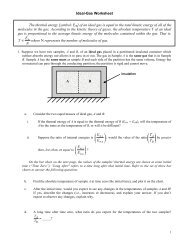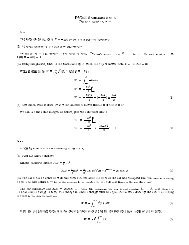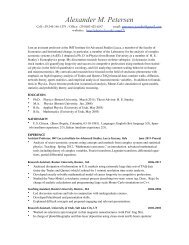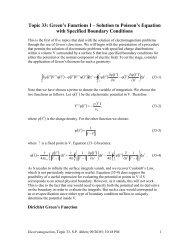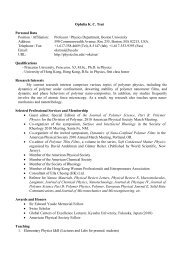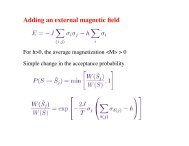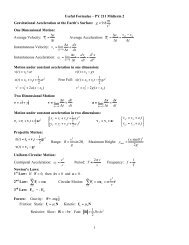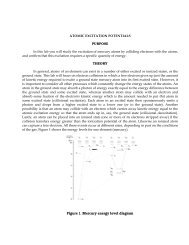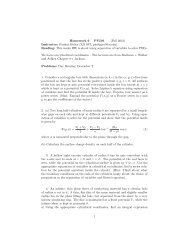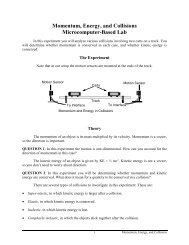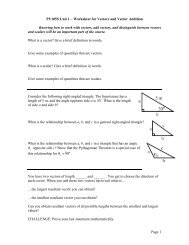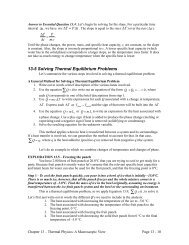Section 8-4: Gravitational Potential Energy - WebAssign
Section 8-4: Gravitational Potential Energy - WebAssign
Section 8-4: Gravitational Potential Energy - WebAssign
Create successful ePaper yourself
Turn your PDF publications into a flip-book with our unique Google optimized e-Paper software.
Answer to Essential Question 8.3: The direction of the gravitational field at a particular point isrepresented by the direction of the field vector at that point (or the ones near it if the point doesnot correspond exactly to the location of a field vector). The relative strength of the field isindicated by the darkness of the arrow. The larger the field’s magnitude, the darker the arrow.8-4 <strong>Gravitational</strong> <strong>Potential</strong> <strong>Energy</strong>The expression we have been using for gravitational potential energy up to this point,, applies when the gravitational field is uniform. In general, the equation forgravitational potential energy is:. (Equation 8.4: <strong>Gravitational</strong> potential energy, in general)This gives the energy associated with the gravitational interaction between two objects, ofmass m and M, separated by a distance r. The minus sign tells us the objects attract one another.Consider the differences between the mgh equation for gravitational potential energy andthe more general form. First, when using Equation 8.4 we are no longer free to define thepotential energy to be zero at some convenient point. Instead, the gravitational potential energy iszero when the two objects are infinitely far apart. Second, when using Equation 8.4 we find thatthe gravitational potential energy is always negative, which is certainly not what we found withmgh. That should not worry us, however, because what is critical is how potential energychanges as objects move with respect to one another. If you drop your pen and it falls to the floor,for instance, both forms of the gravitational potential energy equation give consistent results forthe change in the pen’s gravitational potential energy.Equation 8.4 also reinforces the idea that, when two objects are interacting via gravity,neither object has its own gravitational potential energy. Instead, gravitational potential energy isassociated with the interaction between the objects.EXPLORATION 8.4 – Calculate the total potential energy in a systemThree balls, of mass m,2m, and 3m, are placed in a line,as shown in Figure 8.9. What isthe total gravitational potentialenergy of this system?Figure 8.9: Three equally spaced balls placed in a line.To determine the totalpotential energy of the system,consider the number of interacting pairs. In this case there are three ways to pair up the objects, sothere are three terms to add together to find the total potential energy. Because energy is a scalar,we do not have to worry about direction. Using a subscript of 1 for the ball of mass m, 2 for theball of mass 2m, and 3 for the ball of mass 3m, we get:.Key ideas for gravitational potential energy: <strong>Potential</strong> energy is a scalar. The total gravitationalpotential energy of a system of objects can be found by adding up the energy associated witheach interacting pair of objects. Related End-of-Chapter Exercises: 25, 29, 40.Chapter 8 – Gravity Page 8 - 8
EXAMPLE 8.4 – Applying conservation ideasA ball of mass 1.0 kg and a ball of mass 3.0 kg are initially separated by 4.0 m in a regionof space in which they interact only with one another. When the balls are released from rest, theyaccelerate toward one another. When they are separated by 2.0 m, how fast is each ball going?SOLUTIONFigure 8.10 shows the ballsat the beginning and when they areseparated by 2.0 m. Analyzingforces, we find that the force oneach ball increases as the distancebetween the balls decreases. Thismakes it difficult to apply a forceanalysis. <strong>Energy</strong> conservation is asimpler approach. Our energy equationis:.Figure 8.10: The initial situation shows the balls at rest.The force of gravity causes them to accelerate toward oneanother.In this case, there are no non-conservative forces acting, and in the initial state the kineticenergy is zero because both objects are at rest. This gives. The final kinetic energyrepresents the kinetic energy of the system, the sum of the kinetic energies of the two objects.Let’s solve this generally, using a mass of m and a final speed ofand a mass of 3m and a final speed offor the 1.0 kg ball,for the 3.0 kg ball. The energy equation becomes:.Canceling factors of m gives: .Multiplying through by 2, and combining terms, gives: .Because there is no net external force, the system’s momentum is conserved. There is noinitial momentum. For the net momentum to remain zero, the two momenta must always beequal-and-opposite. Defining right to be positive, momentum conservation gives:, which we can simplify to .Substituting this into the expression we obtained from applying energy conservation:This gives , and .Using m = 1.0 kg, we get and .Related End-of-Chapter Exercises: Problems 43 – 45.Essential Question 8.4: Return to Example 8.4. If you repeat the experiment with balls of mass2.0 kg and 6.0 kg instead, would the final speeds change? If so, how?Chapter 8 – Gravity Page 8 - 9



![arXiv:1303.7274v2 [physics.soc-ph] 27 Aug 2013 - Boston University ...](https://img.yumpu.com/51679664/1/190x245/arxiv13037274v2-physicssoc-ph-27-aug-2013-boston-university-.jpg?quality=85)
